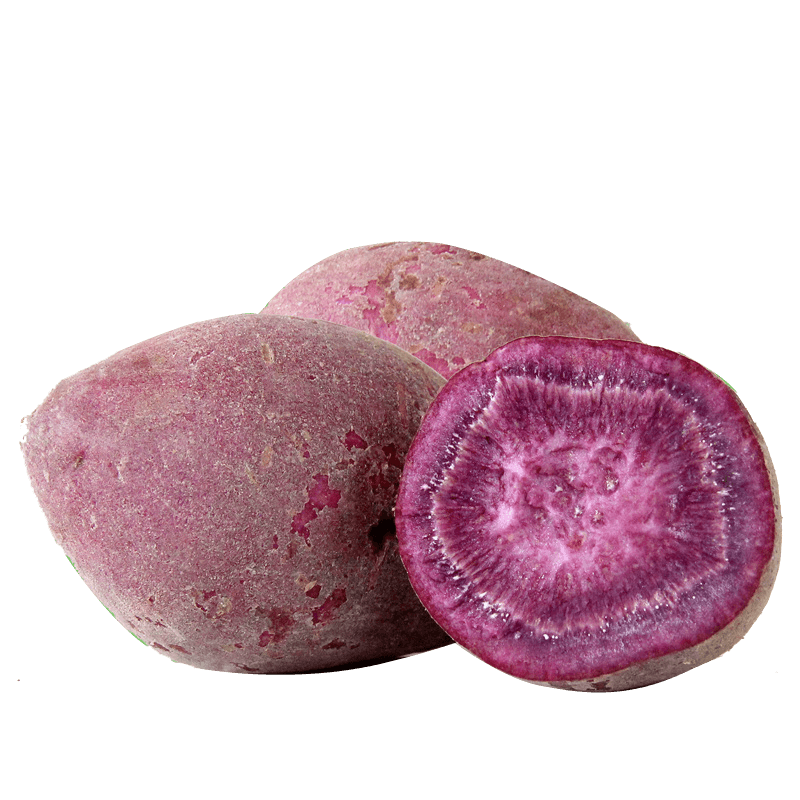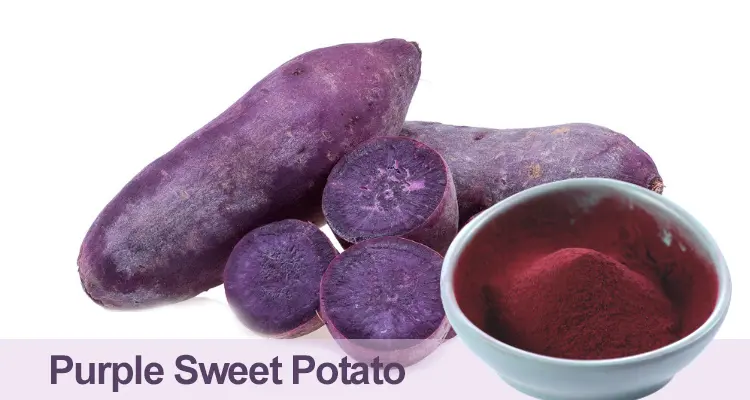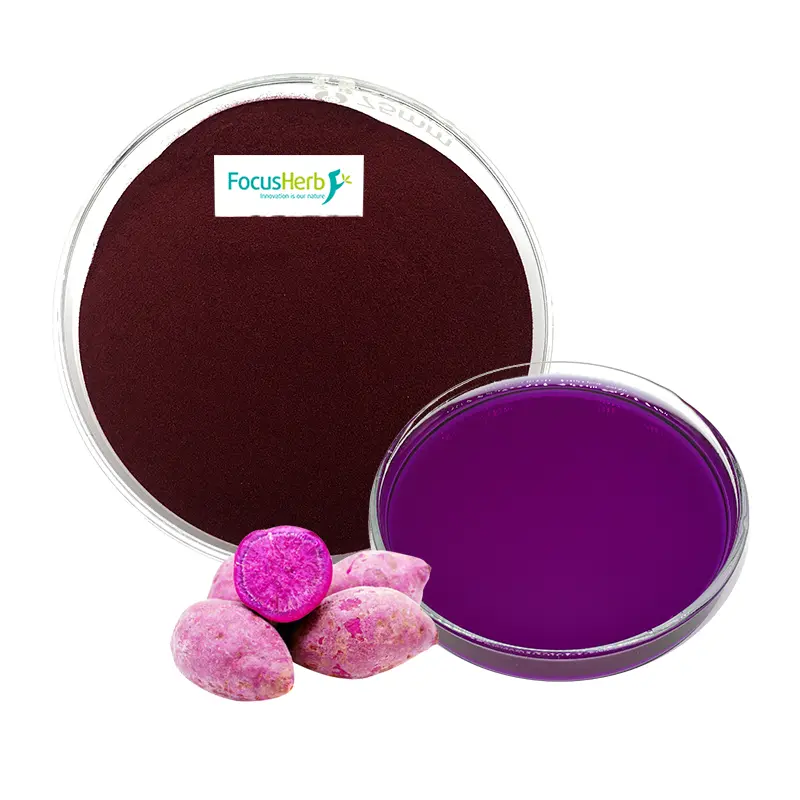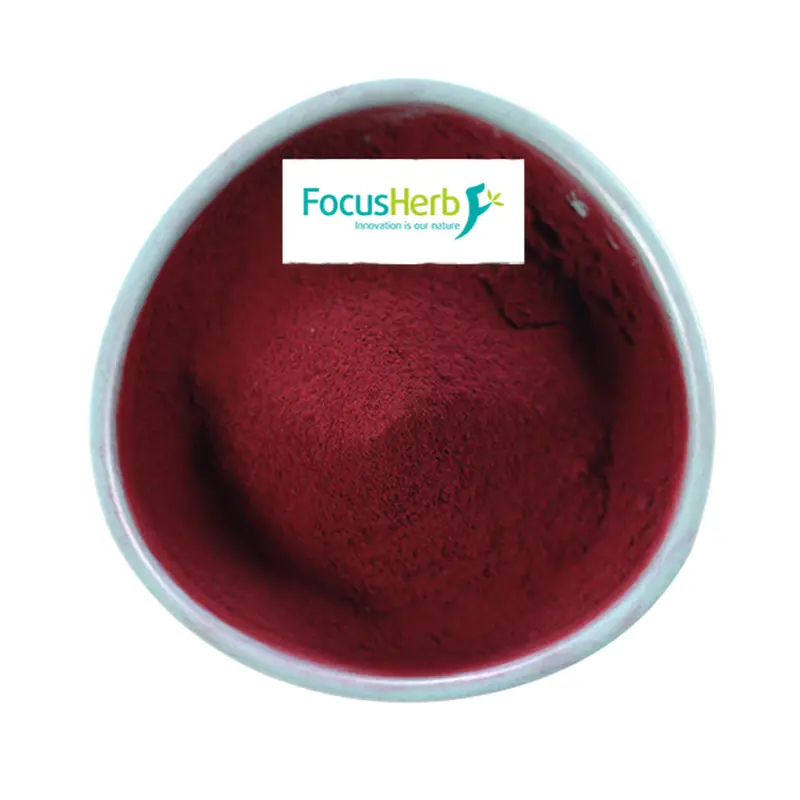Purple Sweet Potato Color , a unique root vegetable, often have a deep purple skin, resembling a delicate application of paint by nature. They are often long, spindle-shaped, and while not smooth, possess a rustic texture. Cutting open a Purple Sweet Potato Color reveals an equally vibrant purple flesh within. The flesh is delicate, firm, and exudes a delicate fragrance, sparking curiosity about the source of its unique color. This mysterious purple color is due to anthocyanins, a natural pigment abundant in Purple Sweet Potato Color. Like a magical painter, these pigments imbue the Purple Sweet Potato Color with its distinctive hue.
Anthocyanins: The “Secret Weapon” of Purple Sweet Potato Color
Powerful Antioxidant Potency
Anthocyanins are a class of water-soluble natural pigments found widely in plants, and the anthocyanins found in Purple Sweet Potato Color are a prime example. They possess remarkable antioxidant power, acting like a valiant guardian, constantly protecting our bodies. During the human body’s metabolic process, free radicals are constantly produced. These extremely active free radicals, like a swarm of rampaging “troublemakers,” can attack cells, disrupting their structure and function, leading to cell damage and aging. The anthocyanins in Purple Sweet Potato Color, like precise “missiles,” quickly bind to these free radicals and neutralize them, effectively reducing free radical damage to cells and slowing the aging process. For example, as we age, the collagen in our skin gradually degrades, causing it to become loose and wrinkled. The antioxidant effects of anthocyanins can slow this loss, maintaining skin’s elasticity and radiance for a more youthful appearance. They also protect various organs in the body, keeping them functioning properly and contributing to better health.
Diverse Health Benefits
Anthocyanins have a multifaceted positive impact on human health. When it comes to preventing cardiovascular disease, they act like a caring “health steward.” Studies have shown that regularly consuming foods rich in anthocyanins can significantly reduce the risk of cardiovascular disease. This is because anthocyanins can enhance the elasticity of blood vessel walls, making them stronger and less prone to rupture. They can also lower blood cholesterol levels and reduce cholesterol deposition on blood vessel walls, thereby effectively preventing the formation of atherosclerosis. A long-term follow-up study of a large population showed that those with a higher intake of anthocyanins in their daily diet had a significantly lower risk of coronary heart disease than those with a lower intake. Anthocyanins can be considered the “guardian” of the eyes when it comes to improving vision. For modern people who frequently use electronic devices for extended periods, eye fatigue, dryness, and even vision loss can occur. Anthocyanins can promote the regeneration of rhodopsin in retinal cells, a substance crucial for vision. Its increased production increases light sensitivity, enhances vision, and relieves eye fatigue and discomfort. Studies examining individuals with poor vision have found that supplementing with anthocyanins significantly improved their vision and alleviated symptoms of eye fatigue. The anthocyanins in purple sweet potatoes, with their unique health benefits, offer valuable health benefits.
A Journey to Extracting Natural Pigments from Purple Sweet Potato Color
A Comprehensive Review of Common Extraction Methods
There are currently several methods for extracting natural pigments from Purple Sweet Potato Color, each with its own unique principles and procedures.
Organic solvent extraction is a relatively common method. It utilizes the principle of like dissolves like. Most factories use organic solvents such as methanol, ethanol, acetone, or mixtures of these as solvents. Imagine the anthocyanins in Purple Sweet Potato Color as a group of “little guests,” and the organic solvent as their preferred “home.” When the Purple Sweet Potato Color is mixed with the organic solvent, the anthocyanins dissolve into the solvent. Adjusting the pH of the solution facilitates the extraction of the anthocyanins from the Purple Sweet Potato Color. To extract the anthocyanins, the Purple Sweet Potato Color is first pre-treated, such as washing, peeling, slicing, or crushing. Then, it is mixed with the selected organic solvent in a specific proportion. Stirring or shaking at an appropriate temperature and time allows for full contact between the two. The anthocyanin-containing solution is then separated by filtration or centrifugation. The aqueous solution extraction method typically involves soaking the Purple Sweet Potato Color raw material in polar hot water at elevated temperature and normal pressure, or even directly at elevated pressure, to extract the anthocyanin-rich raw material. This process is similar to brewing tea, where hot water “infuses” the anthocyanins from the Purple Sweet Potato Color. After soaking, the material is then adsorbed under high pressure using a porous polyester resin material with high polarity and very low pressure. Alternatively, the material is directly extracted using polar deoxygenated water or hot water at atmospheric pressure. Ultrafiltration or reactive permeation is then used, followed by concentration at elevated temperatures, to obtain a crude extract. This method is relatively simple and does not require the use of toxic or hazardous organic solvents.
Ultrasound-assisted extraction utilizes the unique properties of ultrasound. Ultrasound is a high-frequency oscillating mechanical wave that generates pressure waves and shear forces when propagating through a liquid. When the Purple Sweet Potato Color is mixed with the extraction solvent, the pressure waves and shear forces act upon the Purple Sweet Potato Color cells under the action of ultrasound, disrupting their cell walls and membranes. This allows the anthocyanins within the cells to be more easily released into the solvent, accelerating the dissolution and diffusion of the extract. During laboratory processing, the processed Purple Sweet Potato Color and the extraction solvent are placed in an ultrasonic cleaner or specialized ultrasonic extraction equipment. Appropriate parameters such as ultrasonic power, frequency, extraction time, and temperature are set. After a period of treatment, the extract is then subjected to subsequent separation and concentration.
Enzymatic extraction utilizes the catalytic action of enzymes to disrupt the structure of Purple Sweet Potato Color cells. Enzymes such as cellulase and pectinase specifically break down cellulose, pectin, and other components in the cell walls and membranes of Purple Sweet Potato Color. This is like using a pair of “small scissors” to precisely cut through the “constraints” of the cell structure, facilitating the release of anthocyanins from the cells. During the extraction process, the Purple Sweet Potato Color is first crushed to an appropriate particle size. Then, the appropriate amount of enzyme and buffer are added. The pH and temperature are adjusted to allow the enzyme to function in a suitable environment. After a period of enzymatic hydrolysis, the reaction solution is further processed to extract the anthocyanins.
Analysis of the Advantages and Disadvantages of Each Method
Different extraction methods have their own advantages and limitations in terms of extraction yield, cost, environmental impact, and product impact. The organic solvent extraction method works relatively simply, and the performance requirements for production equipment are relatively low, making it easy to implement in some small production enterprises. However, this method has significant drawbacks. Most organic solvents have toxic side effects. Improper handling during the production process can easily harm the health of operators. Furthermore, improper disposal of used organic solvents can pollute the environment. Its organic product extraction yield is generally low, meaning more raw material is required to obtain the same amount of anthocyanins. The crude and refined extracts of Purple Sweet Potato Color anthocyanin pigments obtained using this method typically contain significant amounts of chemical impurities such as starch, reducing agents, and sugars. This makes it difficult to convert the anthocyanins into a white powder after drying, and the extracted anthocyanins are difficult to refrigerate and store, significantly affecting the chemical quality and properties of the product, often requiring complex subsequent purification.
The greatest advantage of the aqueous solution extraction method is its safety and environmental protection. The entire process does not use toxic or hazardous organic solvents, thus avoiding the environmental pollution and health risks associated with organic solvents. Furthermore, water is a cheap and readily available solvent with a low cost. However, this method also has drawbacks. The extraction process requires high temperatures or pressures, which imposes certain equipment requirements, potentially requiring specialized heating or pressurizing equipment, increasing equipment costs. Extraction under high temperature conditions may disrupt the structure of some anthocyanins, affecting their stability and activity, and thus reducing product quality. The resulting crude extract contains numerous impurities, making subsequent separation and purification more complex and increasing production costs.
Ultrasound-assisted extraction offers significant advantages, enabling rapid and efficient extraction of anthocyanins. Ultrasound quickly disrupts the cell structure of purple sweet potatoes, allowing for rapid release of anthocyanins, significantly shortening extraction time and improving production efficiency. This method offers relatively high extraction yields, fully utilizing the anthocyanin resources in Purple Sweet Potato Color. The process is also relatively simple, requiring only ultrasonic equipment. However, this method has certain equipment requirements, requiring specialized ultrasonic equipment, which can be expensive to purchase. Ultrasonic parameters such as power and frequency significantly influence the extraction process. Improper settings can result in reduced extraction yields and even damage to the anthocyanin structure. Furthermore, research on ultrasound-assisted extraction is still incomplete, and large-scale industrial application still faces technical challenges. Enzymatic extraction is environmentally friendly. Enzymes are biocatalysts that function under mild conditions, produce no harmful substances, and are environmentally friendly. They possess high selectivity, specifically breaking down the cellular structure of Purple Sweet Potato Color, reducing the release of impurities, facilitating subsequent separation and purification, and improving product purity. However, the relatively high price of enzymes increases extraction costs, which to some extent limits the large-scale application of this method. Enzyme activity is easily affected by factors such as temperature and pH. Improper control of reaction conditions can reduce or even inactivate enzyme activity, resulting in poor extraction results. Enzymatic hydrolysis reactions typically take a long time, which also affects production efficiency. Different extraction methods have their own advantages and disadvantages. In practical applications, it is necessary to comprehensively consider various factors based on specific needs and conditions to select the most appropriate extraction method to achieve efficient and green extraction of natural Purple Sweet Potato Color pigments.
The Stability Secret of Purple Sweet Potato Color Natural Pigment
(I) Influence of Environmental Factors
Anthocyanins, the natural pigments in Purple Sweet Potato Color, possess unique charm, but their stability is affected by a variety of environmental factors.
Acidity significantly influences the stability of Purple Sweet Potato Color anthocyanins. Anthocyanins act as acid-base indicators, exhibiting distinct changes in structure and color under varying pH conditions. Under acidic conditions, anthocyanins maintain a relatively stable structure, exhibiting a vibrant red or purple color. Purple Sweet Potato Color anthocyanins maintain a vibrant red color when the solution’s pH ranges from 1 to 4. This is because the acidic environment favors the formation of a stable pyranose cation structure, acting as a protective barrier for the anthocyanins, allowing them to maintain their original color and chemical properties. However, when the environment becomes increasingly alkaline, the anthocyanin’s structure changes, transforming into a quinone anion. Its color also gradually darkens, from purple to blue, or even dark blue. This is like breaking the anthocyanin’s “stability barrier,” severely impacting its stability. Improper pH control during food processing and storage can lead to undesirable color changes in the product.
Light is also a significant factor affecting the stability of Purple Sweet Potato Color anthocyanins. Prolonged exposure to light, especially high-energy light like ultraviolet light, causes anthocyanin molecules to absorb energy and undergo photochemical reactions. High-energy particles in sunlight constantly collide with anthocyanin molecules, gradually destroying their structure and causing the color to gradually fade, or even fade. A study comparing solutions containing Purple Sweet Potato Color anthocyanins in light and dark conditions found that after a period of time, the light-exposed solution significantly lighter in color and significantly reduced its anthocyanin content. However, the dark-protected solution retained its original color and anthocyanin content. This clearly demonstrates the negative impact of light on the stability of Purple Sweet Potato Color anthocyanins. Temperature fluctuations also affect the stability of Purple Sweet Potato Color anthocyanins. Within a relatively low temperature range, such as 5-60°C, Purple Sweet Potato Color anthocyanins are relatively stable, with their structure and properties remaining stable. However, as the temperature rises, the thermal motion of anthocyanin molecules intensifies, altering intermolecular interactions and causing their structure to gradually become unstable. At excessively high temperatures, anthocyanins may degrade, breaking down into other substances and losing their original color and efficacy. During high-temperature cooking, if the temperature is not properly controlled, significant anthocyanin loss can occur. This is why it is important to carefully control the temperature and cooking time to minimize anthocyanin loss.
Oxidants and reducing agents also affect the stability of Purple Sweet Potato Color anthocyanins. Oxidants have strong oxidizing properties and can remove electrons from anthocyanin molecules, causing oxidation reactions that disrupt the anthocyanin structure and reduce its stability. Excessive reducing effects can also affect the structure of anthocyanins, reducing their stability. If additives containing oxidizing or reducing agents are used during food processing, their impact on the stability of Purple Sweet Potato Color anthocyanins must be carefully considered to avoid adverse effects on product quality. Metal ions such as Fe⁺, Cu⁺, Zn⁺, Ca⁺, and Ag⁺ can also affect the stability of Purple Sweet Potato Color pigments, causing varying degrees of decrease in absorbance. Naturally colored metal ions such as Fe⁺ and Cu⁺ significantly interfere with the color of Purple Sweet Potato Color pigments, and the degree of color change is significant with increasing concentration.
Countermeasures to Maintain Stability
During food processing and storage, a series of effective measures are necessary to maintain the stability of natural Purple Sweet Potato Color pigments.
Controlling processing and storage conditions is key. During processing, high temperatures and prolonged heating should be avoided as much as possible. Appropriate processing methods, such as low-temperature baking and freeze-drying, should be selected to minimize the damage to anthocyanins caused by temperature. During storage, products containing natural Purple Sweet Potato Color pigments should be stored in a dark, cool, and dry environment to avoid the effects of light and high temperatures on their stability. Dark packaging materials, such as brown glass bottles or black plastic bags, can be used to block light exposure. Storing the product in a low-temperature environment, such as the refrigerator, can also effectively extend its shelf life and maintain the stability of the pigment.
Adding protective agents is also an effective method. Antioxidants, such as vitamin C and vitamin E, can be added. These can donate electrons and react with oxidants, thereby protecting anthocyanins from oxidation. Vitamin C has a strong reducing property and preferentially binds to oxidants, consuming them in the environment and creating a relatively stable environment for anthocyanins. Acidic substances, such as citric acid and tartaric acid, can also be added to adjust the pH of the solution to keep it within the acidic range, which promotes the stability of anthocyanins. Some Purple Sweet Potato Color beverages contain an appropriate amount of citric acid, which not only adjusts the taste but also enhances the stability of the Purple Sweet Potato Color anthocyanins. Microencapsulation technology can also be used to encapsulate Purple Sweet Potato Color anthocyanins, forming tiny capsules to reduce the impact of external environmental factors. These strategies can effectively improve the stability of natural Purple Sweet Potato Color pigments, enabling them to perform better in applications such as food and cosmetics.
Wide Applications of Natural Colors
The Colorful Magic of the Food Industry
In the food industry, natural Purple Sweet Potato Color pigments, like a magical “magician,” play a vital role. They imbue a variety of foods with vibrant colors while enhancing their flavor and quality.
In the beverage industry, Purple Sweet Potato Color pigments are widely used in various fruit juices, teas, and functional beverages. Purple Sweet Potato Color juice beverages made from Purple Sweet Potato Color not only retain the rich nutrients found in Purple Sweet Potato Color, such as dietary fiber, vitamins, and minerals, but also boast a vibrant purple color due to the purple potato pigment, creating a strong visual impact. While enjoying the delicious flavor, people feel as if they are transported to a purple fantasy world. In some mixed juice drinks, Purple Sweet Potato Color pigments are combined with the colors of other fruits to create unique and alluring color combinations. For example, the combination of Purple Sweet Potato Color and mango creates a blend of purple and yellow, enriching the taste and enhancing the visual appeal, offering consumers a brand new drinking experience. Purple Sweet Potato Color pigment also proves useful in baked goods. Adding Purple Sweet Potato Color pigment to bread creates a unique purple hue, making it more appealing to consumers than regular bread. Purple Sweet Potato Color pigment also adds a subtle Purple Sweet Potato Color aroma, enriching the flavor. In cakes, whether chiffon cake, sponge cake, or mousse cake, Purple Sweet Potato Color pigment can exert its unique coloring properties, enhancing the appearance of the cake. Some creative bakeries use Purple Sweet Potato Color pigment to create purple cake bases, pairing them with white cream and fresh fruit. The harmonious color combination and rich taste have become popular with consumers. In biscuits, Purple Sweet Potato Color pigment can also make biscuits stand out, giving them a unique color and flavor, satisfying consumers’ demand for diverse foods.
The confectionery industry also relies on Purple Sweet Potato Color pigment for embellishment. Purple Sweet Potato Color pigment can be used in confectionery products such as hard candies, soft candies, and chewing gum, giving candies a vibrant purple hue and enhancing their appeal. For health-conscious consumers, candies containing natural Purple Sweet Potato Color pigment are more appealing because it is safer and healthier than synthetic pigments. Some children’s candies have also begun using Purple Sweet Potato Color pigment. Its vibrant color and natural properties satisfy children’s love of color while also providing parents with peace of mind.
Purple Sweet Potato Color pigment also plays a significant role in frozen beverages. In products like ice cream, popsicles, and popsicles, Purple Sweet Potato Color pigment imparts a distinctive purple hue, bringing a touch of coolness and a dreamy feel to hot summer days. Purple Sweet Potato Color pigment can also be combined with other flavors to create a rich and diverse taste. For example, Purple Sweet Potato Color-flavored ice cream, which combines the sweetness of Purple Sweet Potato Color with the smoothness of ice cream, is a popular choice among consumers. Some high-end ice cream brands combine Purple Sweet Potato Color pigment with high-quality ingredients like cream and milk to create rich, high-quality Purple Sweet Potato Color ice cream, satisfying consumer demand for high-quality frozen drinks. With its unique color and natural, healthy properties, Purple Sweet Potato Color pigment has brought a rich and diverse range of innovations to the food industry, satisfying consumers’ desire for food with a vibrant color, aroma, and flavor.
Unique Appeal in Other Sectors
In addition to its widespread application in the food industry, Purple Sweet Potato Color pigment has also demonstrated its unique appeal in pharmaceuticals and cosmetics. In the pharmaceutical industry, Purple Sweet Potato Color pigment can be used as a natural colorant. Many medications require the addition of appropriate colorants to facilitate patient identification and administration. Purple Sweet Potato Color pigment, due to its natural and safe properties, is an ideal choice for pharmaceutical coloring. Some oral solutions, capsules, and tablets are added with Purple Sweet Potato Color pigment to alter the drug’s appearance. In some children’s medications, using Purple Sweet Potato Color pigment to color the medication purple not only increases its recognition but also makes it easier for children to accept and improve medication compliance. Purple Sweet Potato Color pigment also has medicinal value. Ingredients such as anthocyanins it contains have antioxidant and anti-inflammatory properties. When combined with other ingredients in medications, they may play a supporting role in the treatment of diseases.
In the cosmetics industry, Purple Sweet Potato Color pigment is also highly sought after. It can be added as a natural colorant to various cosmetics, such as lipstick, eye shadow, blush, and nail polish. Compared to traditional synthetic pigments, Purple Sweet Potato Color pigment is safer and milder, less irritating to the skin, and more suitable for those with sensitive skin. Adding Purple Sweet Potato Color pigment to lipstick creates a natural purple hue, satisfying consumers’ desire for a variety of lip colors. Lipstick made with this natural pigment also moisturizes the lips, thanks to the nutrients in Purple Sweet Potato Color. In eyeshadow and blush, Purple Sweet Potato Color pigment can create unique purple-themed looks, offering consumers a new makeup experience. Adding Purple Sweet Potato Color pigment to nail polish creates a captivating purple luster, enhancing nail beauty. Purple Sweet Potato Color pigment also has skin-care benefits due to its antioxidant and moisturizing properties, helping to maintain healthy skin. Due to its natural, safe, and versatile properties, Purple Sweet Potato Color pigment plays an important role in the pharmaceutical and cosmetic industries, injecting new vitality into these fields.
The Future of Purple Sweet Potato Color Natural Pigments
Looking ahead, Purple Sweet Potato Color natural pigments offer exciting prospects in many areas.
In terms of extraction technology innovation, with the continuous advancement of science and technology, more efficient, environmentally friendly, and low-cost extraction techniques will continue to emerge. Researchers may further optimize existing extraction methods and combine multiple techniques to create synergistic effects, thereby increasing the extraction rate and purity of Purple Sweet Potato Color anthocyanins. Ultrasound-assisted extraction can be combined with enzymatic extraction, using ultrasound to partially disrupt the structure of Purple Sweet Potato Color cells, allowing enzymes to more easily access intracellular substances, thereby enhancing enzymatic hydrolysis and further increasing the release rate of anthocyanins. New extraction technologies may also be developed, such as improved supercritical fluid extraction techniques, which leverage the unique physical properties of supercritical fluids to achieve more precise and efficient extraction and reduce environmental impact.
Purple Sweet Potato Color natural pigments have broad potential for expansion in application areas. In the food industry, beyond existing applications, they may play a role in a wider range of new food products. In customized foods, Purple Sweet Potato Color natural pigments can be added to tailor them to consumers’ health needs and taste preferences, creating uniquely delicious and healthy products. As people’s awareness of intestinal health continues to grow, Purple Sweet Potato Color pigments may be used in functional probiotic foods, not only adding color but also synergizing with probiotics to promote intestinal health. In the pharmaceutical field, beyond its use as a colorant, the medicinal value of Purple Sweet Potato Color pigments may be further explored and applied, leading to the development of more health supplements or medicines using Purple Sweet Potato Color anthocyanins as a primary ingredient to prevent and treat a wider range of diseases. In the cosmetics field, with the increasing demand for natural and safe cosmetics, Purple Sweet Potato Color pigments will have more opportunities to be used in various high-end cosmetics, enabling the development of cosmetics with diverse benefits such as antioxidants, moisturizing, and whitening, satisfying consumers’ dual pursuit of beauty and health.
Purple Sweet Potato Color pigments will also usher in new opportunities in market development. As consumer health awareness continues to rise, demand for natural, safe, and healthy foods and consumer products continues to grow. As a natural pigment, Purple Sweet Potato Color pigments hold broad market prospects. More and more consumers are willing to pay higher prices for products containing natural pigments, which will drive the continued expansion of the Purple Sweet Potato Color pigment market. With the continuous improvement of Purple Sweet Potato Color cultivation technology and the expansion of cultivated areas, Purple Sweet Potato Color production will continue to increase, providing more raw materials for the production of Purple Sweet Potato Color natural pigments, reducing production costs and further enhancing their market competitiveness. Purple Sweet Potato Color natural pigments are expected to achieve greater breakthroughs and developments in various fields in the future, bringing more color and health to people’s lives.






















